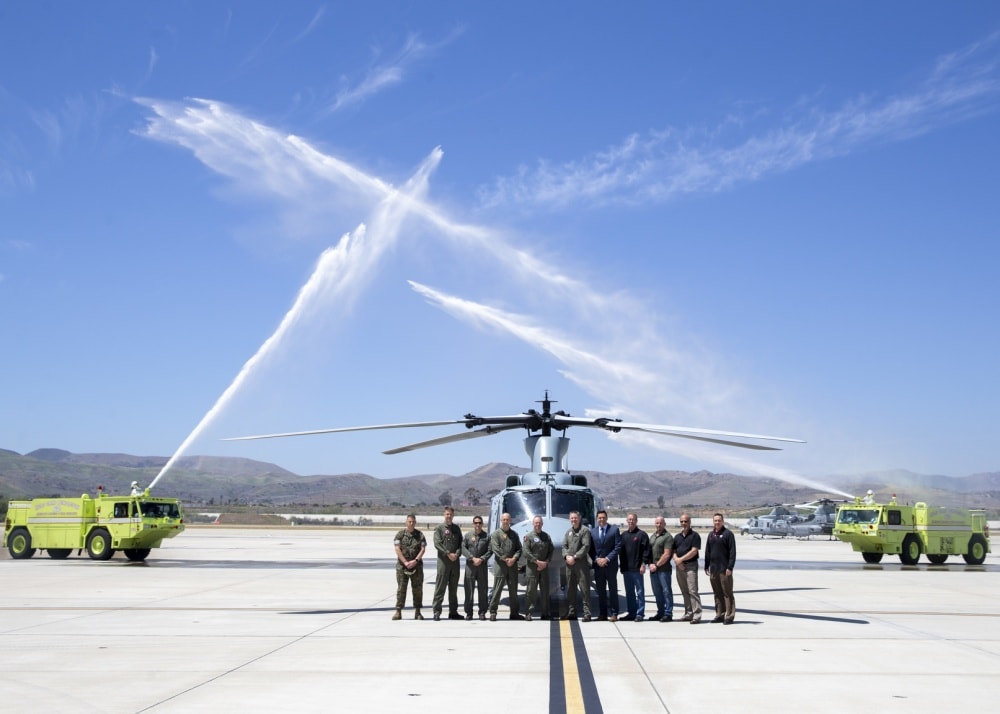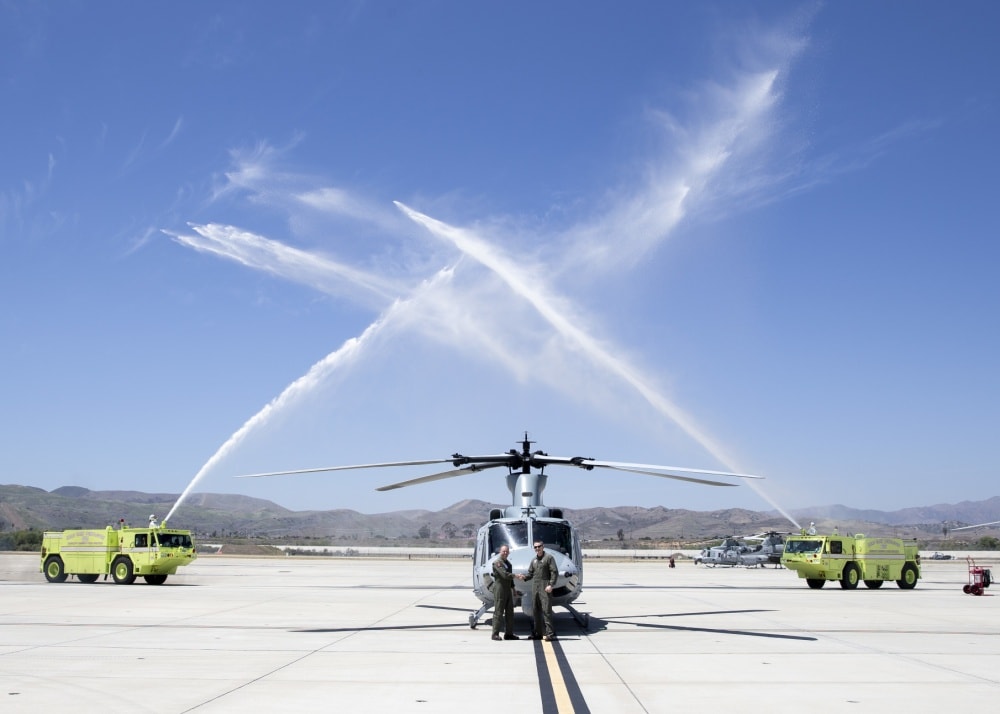U.S. Marines receives final production-era UH-1Y Venom
Posted on
Bell Helicopter delivered the final production-era UH-1Y Venom to the U.S. Marine Corps (USMC).
The Defense Contract Management Agency has reported on 14 January that the final production-era UH-1Y Venom helicopter was delivered to Marine Aircraft Group 39, Camp Pendleton, California.
When a UH-1Y Venom comes off the production line, it weighs more than 11,800 pounds. During the helicopter’s production phase, Marine Corps Lt. Col. Eric Strong has delivered that weight many times. Most significantly, he played a leading role in the program’s historic bookend deliveries.
With anxiety looming due to unfamiliarity, Strong, a Defense Contract Management Agency Bell Helicopter, or DCMA Bell, government flight representative, delivered the first Venom to Marine Light Attack Helicopter Training Squadron 303, Camp Pendleton, California, in 2007.
Eleven years later, steeped in platform expertise, Strong, now serving as DCMA Bell’s chief of flight operations, delivered the final Venom to Marine Light Attack Helicopter Squadron 469, Camp Pendleton, California, in 2018.
“This was an incredible opportunity for me that never happens,” said Strong, who was a captain at the time of the first delivery. “I feel very privileged to have been a part of this program that has undoubtedly made a huge impact on Marine Aviation.”

That impact began in the mid-90’s when the Marine Corps launched a plan to upgrade its aging, 1970’s-era UH-1N Twin Huey (utility) and AH-1 Super Cobra (attack) helicopters. The UH-1Y Venom and the AH-1Z Viper were selected to serve as the latest helicopters within Bell Helicopter’s H-1 family. After scrapping initial plans to remanufacture Venoms using Twin Huey airframes, the “new build” production phase began in 2005.
“Early on, the H-1 Upgrades Program shifted focus to fielding the UH-1Y ahead of the AH-1Z,” said Marine Corps Col. Vic Argobright, the DCMA Bell commanding officer. “This was largely due to the need to replace the aging UH-1N aircraft at a faster pace. Shortly after delivering the first aircraft, the UH-1Y began operating off of ships on (Marine Expeditionary Unit) deployments and in Afghanistan. Because of the need to support operations all the while training aircrew and maintainers, having a steady stream of quality aircraft was critical in supporting a successful transition.”
With warfighter lives on the line, the shift from factory floor to operational unit only takes place after a final list of critical steps are taken.
“As production aircraft complete initial flight tests with Bell, those aircraft are presented to DCMA quality assurance personnel and aircrews for additional acceptance test and inspection,” said Strong. “My role is to conduct both maintenance actions review and in depth inspection of each aircraft to ensure contract adherence. Once inspections are complete, the DCMA pilots will conduct final flight test in accordance with (Naval Air Systems Command) requirements. When flight tests are complete, we sign log books and test vellum completion documents to prepare aircraft for DD-250.”
The Department of Defense Form 250 is the Material Inspection and Receiving Report that is required for most contracts for supplies and services.
“The aircraft is prepped for delivery and we begin flight ferry planning for delivery to the receiving unit,” Strong continued. “Delivery flights to the west coast are normally completed same day and deliveries to the east coast normally take two days.”
In the defense contracting game, an aircraft’s final-delivery often serves as a program’s measuring stick. Was it delivered on time? Was it delivered at cost? Did it meet quality and lethality standards? Much like a family photo crowded with wide smiles and perfect haircuts, these end-product answers don’t tell the whole story. DCMA’s fleet of acquisition professionals navigate many key points throughout the contracting process to ensure picture-perfect deliveries.
“It would be important to note that DCMA Bell is comprised of many centers of excellence in the Fort Worth area, and a satellite office in Amarillo,” said Bryan Lester, a DCMA Bell quality assurance supervisor. “They are comprised of the (contract management office) management, to include the program integrator, the contracts and supply groups, the Drive System Center building the gearboxes, the Rotors and Composites Center building all composites and blades, and the Amarillo Assembly Center for aircraft assembly. The exceptional efforts of all DCMA personnel working in these areas, as one team, provides the ability to meet our agency’s mission and ensure quality product is delivered to the warfighter.”
With all of these rotating parts, communication is vital to program success, according to Shea Lea Vandivere, DCMA Bell H-1 program integrator.

“There is an extensive amount of coordination that goes on behind the scenes between the contractor, NAVAIR and within the multiple centers of DCMA Bell that takes place across a multifunctional support team within each organization,” said Vandivere. “The greatest success is the teamwork that goes into getting these aircraft out to the warfighter to support their mission, which is challenging considering all of the coordination and communication that must occur to ensure that from contract execution to final delivery of these aircraft.
“Without this collective effort of our entire team of contracting, engineering, finance, flight operations, manufacturing, quality assurance, program management, supply chain, and other support functions, this program would not be successful in getting this mission capable aircraft out to the warfighter on time and on budget,” she said.
Now that the Venom production run is complete, Argobright’s team will turn their full attention to sustainment — to maintain and prolong the program’s battlefield capabilities and effectiveness.
“The transition from production to sustainment is not a distinctive event,” Argobright said. “In fact, DCMA Bell has been working the sustainment effort for a number of years. We continue to partner with Bell, NAVAIR, (Naval Supply Systems Command), and the (Defense Logistics Agency) to ensure the USMC gets the support they need. The H-1 program is currently in a critical phase of the sustainment effort with their first Performance Based Logistics contract planned to award next year, all the while working the stand-up of organic capability at Fleet Readiness Center East. DCMA Bell is supporting all sustainment efforts from conducting proposal evaluations to ensuring quality parts are getting to where they need to be on time.”
Much of the sustainment effort will have little to do with Strong. His DCMA Bell responsibilities have shifted to support the last phase of AH-1Z Viper deliveries, but his first-and-last delivery role will keep his Venom experience special.
“There are very few times in a career that you can see the impact you have made, and I feel extremely lucky to have been a part of the beginning and the end of the UH-1Y Upgrade Program,” said Strong.
With his 11-year Venom journey complete, another ending approaches its horizon. Strong is scheduled to retire in 2020. His UH-1Y memories will soon find their own chapter within the adventure of a long military career.
He recalled one of his favorite memories from the early days of the UH-1Y program. Strong said after 1,200 hours in a UH-1N, he was well aware of its weight and power limitations. During his third Venom delivery, he and the aircraft’s pilot, now retired Marine Corps Col. Nick Hall, realized how capable and powerful the UH-1Y was.
“We had just departed Penal Army Airfield in Arizona after a fuel stop,” said Strong. “Two Apache aircraft had lifted from spots on the north side of the airfield. As we began to parallel their flight path, they increased speed to around 140 knots indicated. We matched the speed with ease, and as I glanced at Col. Hall he just smiled. I began to pull pitch to increase speed again. You could clearly see the Apache pilots trying to increase speed by the forward movement of the rotors. As we passed the Apaches and began to pull away from them, Col. Hall said ‘I bet those guys didn’t expect to see that.’”
Subscribe to our newsletter
Promotions, new products and sales. Directly to your inbox.
